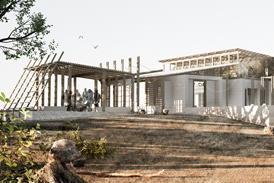- Home
- Intelligence for Architects
- Subscribe
- Jobs
- Events

2025 events calendar Explore now 
Keep up to date
Find out more
- Programmes
- CPD
- More from navigation items
First home in UK built from modern version of cob completes

The house in Norfolk was designed by Hudson Architects and was built from a mixture of subsoil, straw and hemp
The first UK home to be built from CobBauge, a modern take on cob construction has been completed by Hudson Architects in Fakenham, Norfolk. The walls of the three bedroom single storey home were constructed from an inner layer of structural cob, a mixture of subsoil and straw, and an outer insulating layer of cob with a high percentage of hemp shiv which is a good insulator. The walls were built on a stone plinth to protect the material from the damp ground and finished with white render which protects the walls from physical damage and rain. The building features a shallow pitched sedum roof with a generous overhang which also helps protect the walls from rain.
…
This content is available to registered users | Already registered?Login here
You are not currently logged in.
To continue reading this story, sign up for free guest access
Existing Subscriber? LOGIN
REGISTER for free access on selected stories and sign up for email alerts. You get:
- Up to the minute architecture news from around the UK
- Breaking, daily and weekly e-newsletters
Subscribe to Building Design and you will benefit from:

- Unlimited news
- Reviews of the latest buildings from all corners of the world
- Technical studies
- Full access to all our online archives
- PLUS you will receive a digital copy of WA100 worth over £45
Subscribe now for unlimited access.






